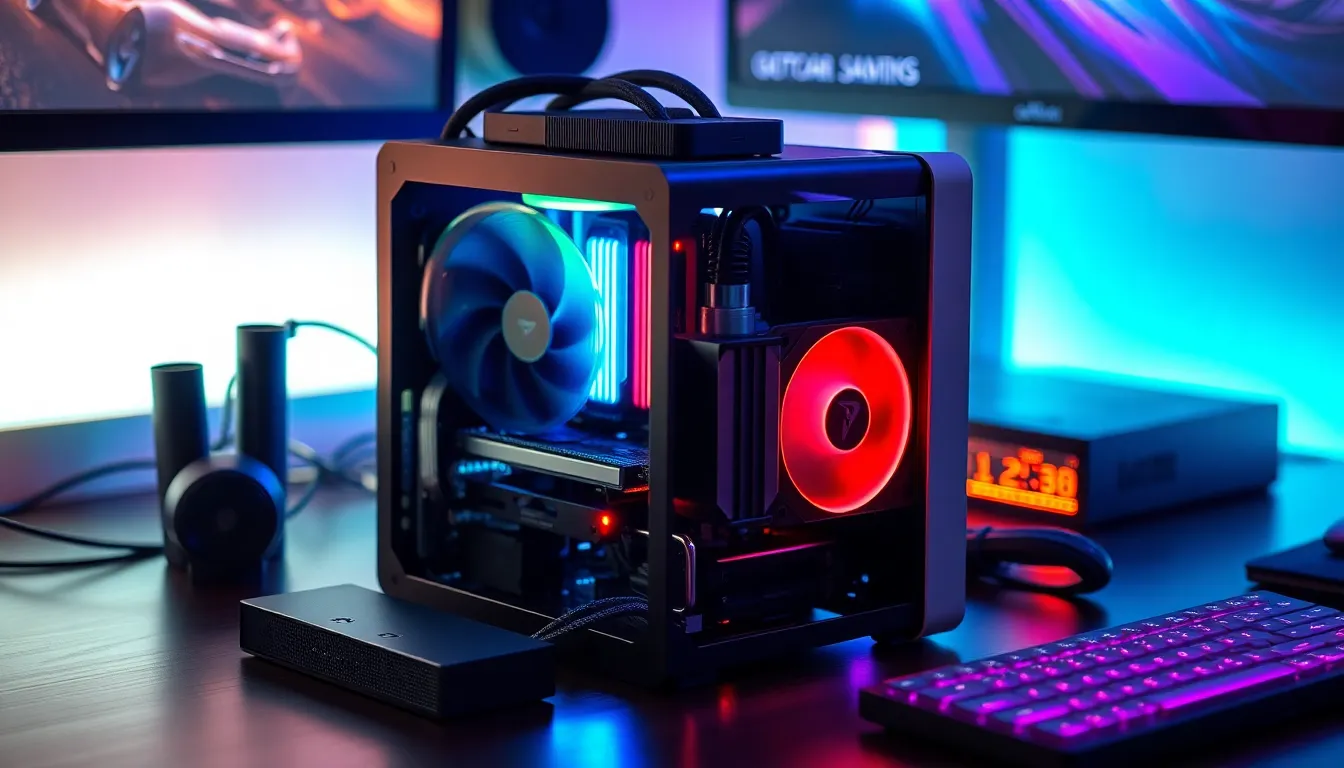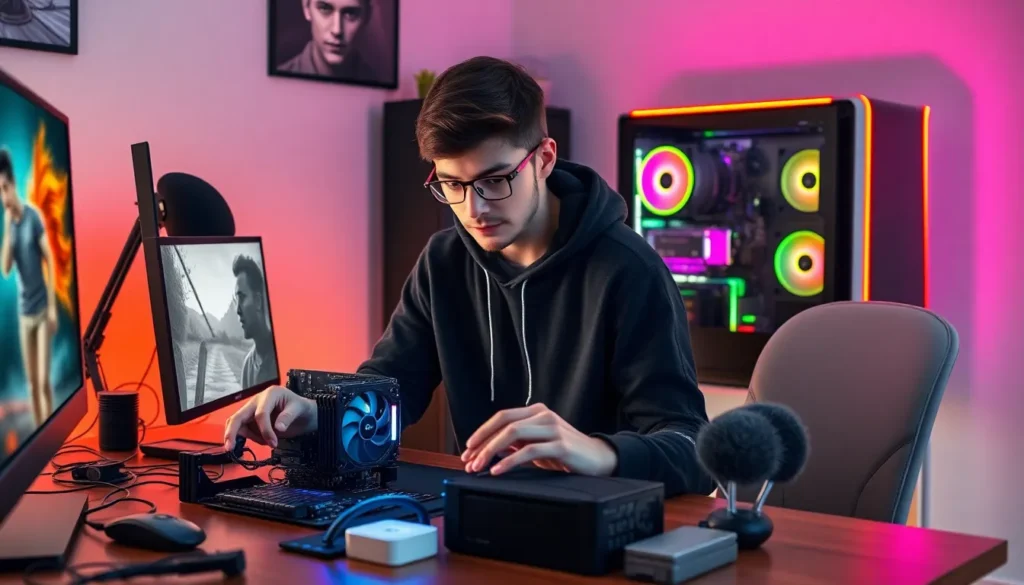In a world where gaming rigs often resemble small cars, the mini gaming PC is the sleek, fuel-efficient sports car that’s turning heads. Imagine a powerhouse that fits snugly on your desk or even in your backpack, ready to unleash epic gaming sessions without sacrificing performance. It’s the ultimate blend of portability and power, proving that good things really do come in small packages.
Building a mini gaming PC isn’t just for tech wizards; it’s for anyone who wants to level up their gaming experience without the bulk. With the right components, you can create a compact beast that runs the latest titles smoothly while looking stylish. Plus, who wouldn’t want to impress friends with a setup that’s as cute as it is capable? Let’s dive into the world of mini gaming PCs and discover how to build one that’ll make even the most hardcore gamers green with envy.
Mini Gaming PC Build
Mini gaming PCs offer a unique blend of performance and portability, making them appealing for gamers seeking a streamlined experience. These compact systems typically use powerful components to ensure fluid gameplay in a smaller footprint. Choosing the right parts becomes crucial to maximize performance while minimizing space.
Key components of a mini gaming PC include the motherboard, CPU, GPU, and cooling solutions. Selecting a mini-ITX or micro-ATX motherboard allows for a compact setup with essential connectivity options. A high-performance CPU, such as AMD Ryzen or Intel Core, contributes significantly to gaming capabilities.
Graphics performance stands out as one of the most important aspects of any gaming build. Utilizing a small form factor GPU, such as NVIDIA’s RTX series or AMD’s RX series, ensures gamers enjoy vivid graphics without sacrificing space. Effective cooling solutions, such as all-in-one liquid coolers or compact air coolers, play a major role in maintaining optimal temperatures, especially in tight enclosures.
Storage options in mini gaming PCs typically include SSDs for fast load times. Installing a 1TB NVMe SSD often provides ample space and speed for games and applications. Users looking for additional storage may opt for a secondary HDD for larger file storage.
Integrating these components into a mini gaming PC requires careful planning. System builders should ensure compatibility and airflow are prioritized during the assembly process. Many cases provide cable management solutions, which contribute to overall aesthetics and airflow.
Building a mini gaming PC opens up opportunities for gamers to create a visually appealing setup that doesn’t compromise on performance. Compact designs can easily fit into various spaces, enabling flexibility in placement while delivering an exceptional gaming experience.
Key Components for Your Build

Building a mini gaming PC requires careful selection of core components to ensure optimal performance in a compact form factor. Key elements include the CPU, GPU, and motherboard.
CPU Selection
Choosing the right CPU is essential for gaming performance. High-performance options like AMD Ryzen 5 or Intel Core i5 create a balanced setup for gaming. With multiple cores and threads, these CPUs handle demanding games efficiently. Gamers should prioritize clock speed and thermal performance to maintain optimal functionality under load. Many mini gaming PCs benefit from CPUs with integrated graphics, providing a fallback in case a dedicated GPU is unavailable. It’s critical to align CPU selection with the intended gaming style and workload.
GPU Options
Selecting the right GPU significantly impacts graphical performance. Compact solutions like NVIDIA’s RTX 3060 or AMD’s RX 6600 XT fit mini builds without sacrificing capability. Performance varies based on the chosen resolution and settings, so consider these factors when making a selection. High refresh rates in modern titles also depend on a robust GPU. The cooling system in mini cases often requires consideration, meaning smaller GPUs designed for airflow optimization will enhance performance while avoiding overheating. Gamers must balance budget, power, and performance for the best results.
Motherboard Choices
The motherboard connects all components in a mini gaming PC. Mini-ITX and micro-ATX options provide compact dimensions while supporting powerful hardware. Features such as PCIe slots and RAM capacity play vital roles in future upgrades. Connectivity is also crucial; look for motherboards with USB 3.2 ports and built-in Wi-Fi for convenience. Compatibility with the selected CPU and GPU ensures a seamless build. Reviewing user reviews for specific motherboards can inspire confidence in choices to make. Prioritizing quality here aids in building a relationship between the performance components in the system.
Benefits of Mini Gaming PCs
Mini gaming PCs offer several advantages that appeal to gamers seeking performance and convenience. Compact designs make these systems perfect for limited spaces while delivering high-end gaming capabilities.
Space Saving
Compact dimensions of mini gaming PCs significantly reduce their footprint, allowing placement in smaller areas. These systems easily fit on desks, shelves, or entertainment centers, contributing to a cleaner, more organized workspace. By minimizing space usage, gamers can maximize their environment without sacrificing performance. Opting for these smaller builds encourages innovative layouts, freeing up zones for additional peripherals like controllers or VR setups. Simplified transportation enhances versatility for mobile gamers, allowing them to take their setups to friends’ homes or events.
Power Efficiency
Mini gaming PCs excel in power efficiency, consuming less energy than traditional gaming rigs. Efficient components like modern CPUs and GPUs reduce electricity bills without hindering performance. Lower wattage power supplies contribute to quieter operations and less heat generation, enhancing long-term reliability. With integrated energy-saving technologies, these systems adapt power usage based on performance demands. Users benefit from longer-lasting components, as reduced heat leads to decreased wear. Overall, power efficiency in mini gaming PCs supports sustainable gaming practices while maintaining high-quality experiences.
Considerations Before Building
Before starting a mini gaming PC build, careful planning enhances the ultimate outcome. Several key factors to weigh include budgeting and cooling solutions.
Budgeting Your Build
Determining a budget sets the foundation for the entire build. Aim for a clear outline of component costs, ensuring to allocate funds for essential hardware like CPU, GPU, and motherboard. Expect to spend between $700 and $1,500 for a decent setup, depending on performance needs. Consider additional expenses for peripherals and software, which can impact the total investment. Prioritizing high-quality components leads to better longevity and performance. Research ongoing deals or discounts to optimize cost efficiency. Look into different retailers to compare prices, maximizing value without sacrificing quality.
Cooling Solutions
Effective cooling solutions play a vital role in maintaining system performance. Mini gaming PCs often experience tighter thermal constraints, making temperature management essential. Opt for compact solutions like all-in-one liquid coolers or efficient air coolers that fit confined spaces. Consider airflow design in the case to enhance thermal efficiency. Evaluate options such as case fans for additional ventilation, especially in hotter climates. Search for products with low noise levels to ensure a quiet gaming experience. Investing in reliable cooling now prevents future overheating issues, safeguarding hardware integrity long-term.
Conclusion
Building a mini gaming PC offers an exciting opportunity for gamers to enjoy high performance in a compact form. The thoughtful selection of components ensures that these systems not only deliver impressive graphics and speed but also fit seamlessly into any space. With careful planning and attention to detail, anyone can create a setup that’s both powerful and stylish.
As gaming technology continues to evolve, mini gaming PCs stand out for their efficiency and portability. They provide a practical solution for gamers who value both aesthetics and performance. Whether for casual gaming or competitive play, a mini gaming PC can elevate the experience while saving space and energy. Embracing this trend might just be the best decision for the modern gamer.

